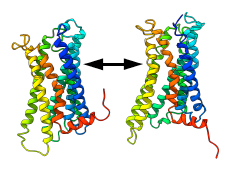Structural Proteomics

Description
We develop new methods where mass spectrometry is used for the study of structure–function relationships of ligand–receptor interactions. While G-protein coupled receptors (GPCRs) remain the major target (~35% of all therapeutic drugs) for drug development, experimental verification of the interaction sites where their cognate ligands bind are still lacking for many GPCRs. These efforts allow us to characterize the structural location of the binding site for a ligand in a receptor, the binding affinity and effects of competitive binding, and the reaction kinetics for the binding event at submillisecond temporal resolution. In turn, these studies provide fundamental knowledge of physicochemical properties of ligand-receptor interactions that are key for design of future biological therapeutics.
We also focus on method development where mass spectrometry is used to probe the proteome at temporal resolution down to the single-cell level. In contrast to ensemble average measurements, single-cell studies aim to unravel information about cellular heterogeneity, and will determine how much variability there is within a certain cell type in a tissue compared to others. Recent efforts have showed how peptide hormone processing differs between gamma-cells located in different sites of the rat pancreas with single-cell mass spectrometry,
